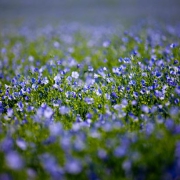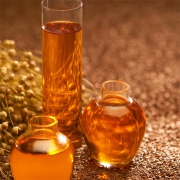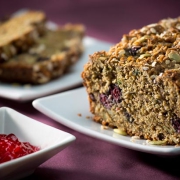What is Flax?
Flax is an annual plant belonging to the genus Linum. The genus contains more than 100 annual and perennial species with cultivated flax belonging to L. usitatissimum – the most used and most useful of the entire genus. The primary varieties are of two types: one is grown primarily for its oil and the other primarily for its fiber.
Flax has a growing time (from seeding until harvest) of 90 days to 125 days, flax may grow from 15 to 36 inches (40-90 cm) tall with a branched taproot that may be more than 3 feet (1 m) in length with side root branches stretching up to 15 inches (30 cm).
Flax is a slender stalked plant, with 5-petaled flowers that are usually blue in colour. They appear each morning during the flowering period and are shed in the afternoon. Once the flower is gone, the onion-shaped seed boll begins to form. Upon maturation it may contain up to ten shiny, flattened, oval seeds. They may vary in colour from reddish brown to a golden yellow colour. One thousand flax seeds would weigh less than 0.25 oz (7 grams). Each seed contains 43% - 45% oil and has a protein content of 21% - 25%.
Seed that is harvested for its commercial oil content (also known industrially as linseed oil) is used in a variety of applications. Industrial linseed oil is a main ingredient in the production of linoleum flooring and in quality oil- based paints and stains.
Top quality seed, either whole or ground and cold-pressed flax oil may enter the human use market as a food or a feed ingredient. In fact, flax products with their high omega 3 and fibre contents are recognized for their health benefits. Increasingly, flax in its various forms is entering both the pet food and livestock diets including those of chickens, hogs and cattle providing improved animal health and increased production.
Flax is also recognized as a bast plant; one of a group of plants characterized by long, strong fibers that comprise the outer layer of the stalk. The word bast refers to the outer portion of the stem of the plant and is the part that the fiber used to make linen is derived from. The remainder of the stem inside the bast layer is a different type of fibrous material and in the flax plant it is known as shives.
Industry Overview in Canada
Flax or as it is also referred to as linseed, has been consumed for thousands of years. Over the centuries, the production of flax spread across Europe, Africa and finally to North America where it was the first oilseed to be widely grown in Western Canada.
Canada is the world's largest producer and exporter of flax with annual exports valued at CAN$150-180 million (M). As a result, market conditions in Canada have a significant impact on global flax prices.
Production
Canada is the largest producer of flaxseed in the world, representing about 40% of world production. China, the United States (US), and India, together account for 40% of world production. Within the European Union (EU), the main producers of flaxseed are Germany, the United Kingdom and France.
Virtually all of the flaxseed grown in Western Canada is destined for the export market as flax oil, flaxseed meal, and flax fiber. Saskatchewan, on average, produces four times as much as Manitoba, and has been the largest producing province since 1993-1994. Just over 1 of every 4 farms in Saskatchewan include flax as part of their rotation.
Demand
Over the last century, flax has experienced major shifts in demand. Technological developments since the 1950s, such as the increased use of water based paints and petroleum based floor coverings, reduced industrial demand for flax. In the late 1990s however, the trend towards environmentally friendly and health-oriented products opened new opportunities for flax. The non-allergenic and biodegradable characteristics of linoleum, along with quality improvements, have led to a resurgence of demand for linoleum in some parts of Europe.
Further, the awareness of flax as a beneficial food and feed has been increasing among the North American population. Over the last decade in North America, the use of flax in breads, bagels and other baked goods has tripled the demand for flax in the food industry. Some other niche markets for flax include premium pet foods, which improve the overall health and appearance of cats, dogs and horses. The majority of flax in North America is consumed as feed; while in China and India it is mostly consumed as food.




